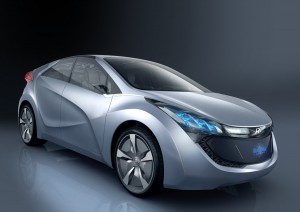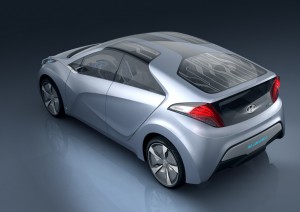
The HND-4 is powered by a 1.6-liter four-cylinder engine, coupled to a continuously variable transmission and a 100 kW electric motor.
While automakers are busy cancelling budget-busting appearances at auto shows, there still are some makers producing concept cars for the diminishing number of venues. The Hyundai Motor Company has just released the first shots of the HND-4, a plug-in hybrid electric vehicle or HEV. The car, named “Blue-Will” (블루 윌), will be displayed at the Seoul Motor Show, which opens April 2nd.
The HND-4 is powered by all-aluminum, direct injection, 1.6-liter four-cylinder engine, which is coupled to a continuously variable transmission and a 100 kW electric motor. It is a parallel hybrid drive configuration. It was not immediately clear just how sophisticated the system is or how much the electric motor contributes to the package. No mileage or range figures were claimed.
Electric power is stored in a Lithium Polymer battery pack, which is next to the fuel tank under the rear seat in an attempt to preserve some trunk room. Packaging of bulky battery packs remains a challenge for EV designers, to say nothing of the high cost.
Hyundai claims it will be the first automaker in the world to apply Lithium Polymer battery technology in a mass production vehicle when the Elantra LPI Hybrid Electric Vehicle goes on sale in Korea this July.
As to this latest concept, there is the usual design babble accompanying the photos, made even more amusing by translation quirks. “Eco-sleeker” was the core concept driving the design process. Its sweeping character lines and detailed form elevate this next generation hybrid to an entirely new level,” Hyundai said.

Electric power is stored in a Lithium Polymer battery pack, which is next to the fuel tank under the rear seat.
There are some, tenuous, green connections: Recycled PET bottles were used for the headlamp trim, and other uses have been found for recycled plastics; PLA for the interior, while PA11 was specified for the engine cover. An interesting — though probably far from production — touch is the panoramic roof where the glass area has solar cells that are transparent.
While it’s all too easy to poke fun at concept cars, Hyundai remains a serious company. And like the World Baseball Classic that just saw Korea lose to Japan in a tough, extra-inning ball game, Hyundai is showing signs of being able to play in the automotive big leagues.
Established in 1967, Hyundai Motor Co. has grown into the Hyundai-Kia Automotive Group which was ranked as the world’s fifth-largest automaker in 2007. Hyundai vehicles are now sold in 193 countries through some 6,000 dealerships and showrooms. Further information about Hyundai Motor Company and its products is available at http://www.hyundai-motor.com
